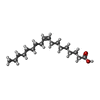+Search query
-Structure paper
| Title | Molecular mechanism of the wake-promoting agent TAK-925. |
|---|---|
| Journal, issue, pages | Nat Commun, Vol. 13, Issue 1, Page 2902, Year 2022 |
| Publish date | May 25, 2022 |
 Authors Authors | Jie Yin / Yanyong Kang / Aaron P McGrath / Karen Chapman / Megan Sjodt / Eiji Kimura / Atsutoshi Okabe / Tatsuki Koike / Yuhei Miyanohana / Yuji Shimizu / Rameshu Rallabandi / Peng Lian / Xiaochen Bai / Mack Flinspach / Jef K De Brabander / Daniel M Rosenbaum /    |
| PubMed Abstract | The OX orexin receptor (OXR) is a highly expressed G protein-coupled receptor (GPCR) in the brain that regulates wakefulness and circadian rhythms in humans. Antagonism of OXR is a proven therapeutic ...The OX orexin receptor (OXR) is a highly expressed G protein-coupled receptor (GPCR) in the brain that regulates wakefulness and circadian rhythms in humans. Antagonism of OXR is a proven therapeutic strategy for insomnia drugs, and agonism of OXR is a potentially powerful approach for narcolepsy type 1, which is characterized by the death of orexinergic neurons. Until recently, agonism of OXR had been considered 'undruggable.' We harness cryo-electron microscopy of OXR-G protein complexes to determine how the first clinically tested OXR agonist TAK-925 can activate OXR in a highly selective manner. Two structures of TAK-925-bound OXR with either a G mimetic or G reveal that TAK-925 binds at the same site occupied by antagonists, yet interacts with the transmembrane helices to trigger activating microswitches. Our structural and mutagenesis data show that TAK-925's selectivity is mediated by subtle differences between OX and OX receptor subtypes at the orthosteric pocket. Finally, differences in the polarity of interactions at the G protein binding interfaces help to rationalize OXR's coupling selectivity for G signaling. The mechanisms of TAK-925's binding, activation, and selectivity presented herein will aid in understanding the efficacy of small molecule OXR agonists for narcolepsy and other circadian disorders. |
 External links External links |  Nat Commun / Nat Commun /  PubMed:35614071 / PubMed:35614071 /  PubMed Central PubMed Central |
| Methods | EM (single particle) |
| Resolution | 3.17 - 3.3 Å |
| Structure data | EMDB-25389, PDB-7sqo: EMDB-25399, PDB-7sr8: |
| Chemicals |  ChemComp-OLA:  ChemComp-A6F: |
| Source |
|
 Keywords Keywords |  MEMBRANE PROTEIN / CLASS A GPCR / MEMBRANE PROTEIN / CLASS A GPCR /  SIGNALING PROTEIN / SIGNALING PROTEIN /  orexin / orexin /  GPCR / narcolepsy GPCR / narcolepsy |
 Movie
Movie Controller
Controller Structure viewers
Structure viewers About Yorodumi Papers
About Yorodumi Papers









